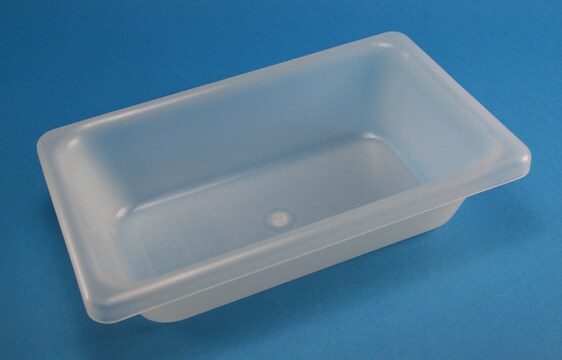SCC447
OSUMMER.3 Mouse NRAS-Mutant Melanoma Cell Line
Human
Zaloguj sięWyświetlanie cen organizacyjnych i kontraktowych
About This Item
Kod UNSPSC:
41106514
NACRES:
NA.81
Polecane produkty
product name
OSUMMER.3 Mouse NRAS-Mutant Melanoma Cell Line,
pochodzenie biologiczne
human
Poziom jakości
opakowanie
vial of ≥1X10⁶ cells/vial mg
producent / nazwa handlowa
Millipore
tryb wzrostu
N/A
metody
cell analysis: suitable
Warunki transportu
liquid nitrogen
temp. przechowywania
−196°C
Zastosowanie
Each vial contains >1X106 viable cells.
Cells are tested negative for infectious diseases by a Mouse Essential CLEAR Panel by Charles River Animal Diagnostic Services.
Cells are verified to be of mouse origin and negative for inter-species contamination from rat, human, Chinese hamster, Golden Syrian hamster, and Non-human Primate (NHP) as assessed by a Contamination Clear panel by Charles River Animal Diagnostic Services
Cells are negative for mycoplasma contamination.
Cells are tested negative for infectious diseases by a Mouse Essential CLEAR Panel by Charles River Animal Diagnostic Services.
Cells are verified to be of mouse origin and negative for inter-species contamination from rat, human, Chinese hamster, Golden Syrian hamster, and Non-human Primate (NHP) as assessed by a Contamination Clear panel by Charles River Animal Diagnostic Services
Cells are negative for mycoplasma contamination.
The OSUMMER (Ohio State University and Moffitt Melanoma Exposed to Radiation) cell lines fill a previously unfilled gap in melanoma biology. The OSUMMER cell lines are syngeneic to C57BL/6 laboratory mice and have genetic profiles that are similar to human tumors, making them responsive to immunotherapy treatments. These NRAS-Mutant cell lines can be used to discover and address potential immunotherapies in NRAS-mutant human melanomas which make up an estimated 15-25% of human melanomas. These cell lines also enable in vivo testing of immunotherapies with a mouse model.
OSUMMER.3 NRAS mouse melanoma cell line was derived from a female TN mouse exposed to UVA and UVB radiation. OSUMMER.3 carries the specific NRAS mutation Q61R and can form tumors in vivo without Matrigel injection. WES revealed high SNV (Single Nucleotide variants) and low CNA (Copy Number Alterations) burden, as well as the presence of UV signature mutations. OSUMMER.3 cells express the melanoma markers, PMEL and MelanA, and exhibit robust growth in culture.
Source
OSUMMER.3 was derived from melanoma induced in TN (Tyr::CreER) mice exposed to UVA or UVB radiation on postnatal day 3 (1).
References
1. Bowman, R. L., et al. (2021). UVB mutagenesis differs in Nras-and Braf-mutant mouse models of melanoma. Life Science Alliance, 4(9).
OSUMMER.3 NRAS mouse melanoma cell line was derived from a female TN mouse exposed to UVA and UVB radiation. OSUMMER.3 carries the specific NRAS mutation Q61R and can form tumors in vivo without Matrigel injection. WES revealed high SNV (Single Nucleotide variants) and low CNA (Copy Number Alterations) burden, as well as the presence of UV signature mutations. OSUMMER.3 cells express the melanoma markers, PMEL and MelanA, and exhibit robust growth in culture.
Source
OSUMMER.3 was derived from melanoma induced in TN (Tyr::CreER) mice exposed to UVA or UVB radiation on postnatal day 3 (1).
References
1. Bowman, R. L., et al. (2021). UVB mutagenesis differs in Nras-and Braf-mutant mouse models of melanoma. Life Science Alliance, 4(9).
Cechy i korzyści
OSUMMER.3 carries the specific NRAS mutation Q61R and may be used to create syngeneic mouse melanoma models.
Przechowywanie i stabilność
The cells should be stored in liquid nitrogen. The cells can be cultured for at least 10 passages after initial thawing without significantly affecting the cell marker expression and functionality.
Inne uwagi
This product is intended for sale and sold solely to academic institutions for internal academic research use per the terms of the “Academic Use Agreement” as detailed in the product documentation. For information regarding any other use, please contact licensing@emdmillipore.com.
Oświadczenie o zrzeczeniu się odpowiedzialności
Unless otherwise stated in our catalog or other company documentation accompanying the product(s), our products are intended for research use only and are not to be used for any other purpose, which includes but is not limited to, unauthorized commercial uses, in vitro diagnostic uses, ex vivo or in vivo therapeutic uses or any type of consumption or application to humans or animals.
Ta strona może zawierać tekst przetłumaczony maszynowo.
produkt powiązany
Kod klasy składowania
10 - Combustible liquids
Klasa zagrożenia wodnego (WGK)
WGK 2
Temperatura zapłonu (°F)
Not applicable
Temperatura zapłonu (°C)
Not applicable
Certyfikaty analizy (CoA)
Poszukaj Certyfikaty analizy (CoA), wpisując numer partii/serii produktów. Numery serii i partii można znaleźć na etykiecie produktu po słowach „seria” lub „partia”.
Masz już ten produkt?
Dokumenty związane z niedawno zakupionymi produktami zostały zamieszczone w Bibliotece dokumentów.
Nasz zespół naukowców ma doświadczenie we wszystkich obszarach badań, w tym w naukach przyrodniczych, materiałoznawstwie, syntezie chemicznej, chromatografii, analityce i wielu innych dziedzinach.
Skontaktuj się z zespołem ds. pomocy technicznej